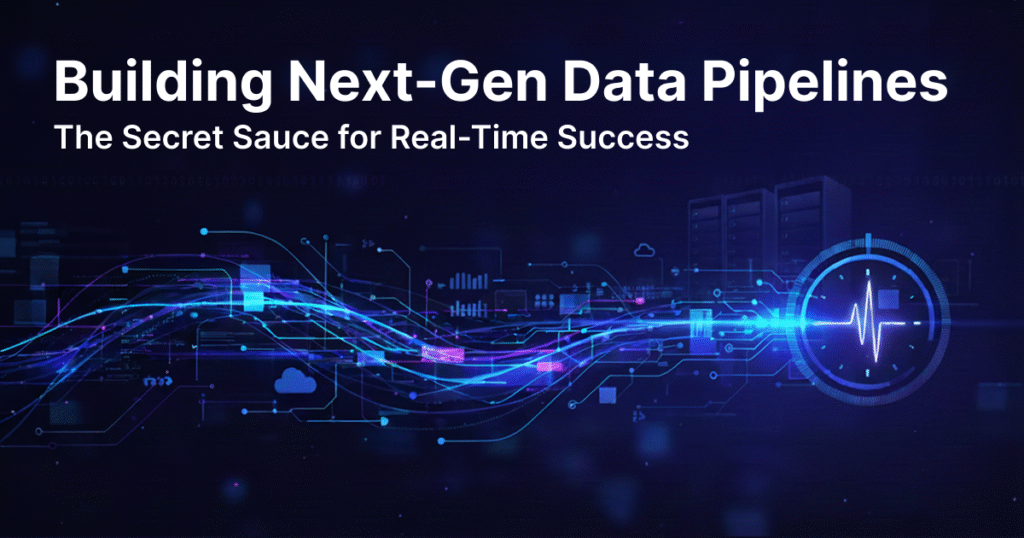Ever feel like you’re constantly a step behind? Like by the time you get the numbers, the market has already moved? That’s a feeling a lot of us can relate to, especially in the fast-paced, digital-first India we live in today. We see it everywhere: from the stock market tickers flashing on our phones to the surge pricing on our ride-hailing apps. The world is moving at lightning speed, and to stay ahead, our businesses need to move just as fast.
This is where the magic of Real-Time Data Pipelines comes in. It’s not just a fancy tech term; it’s the fundamental shift that’s powering the smartest companies today. Forget waiting for data to be processed overnight. This is about making decisions in the moment. This isn’t just about a new tool; it’s about a whole new way of thinking—it’s the essence of Next-Gen Data Engineering.

Why Yesterdays' Data Just Doesn't Cut It Anymore
Think about a typical day in a bustling Indian city. A leading e-commerce company like Flipkart wants to offer a personalized flash sale to a customer based on what they’re browsing right now. A logistics giant like Delhivery needs to reroute a delivery truck instantly because of unexpected traffic on the Outer Ring Road. A private bank in Mumbai needs to spot a fraudulent transaction the very second it happens to protect a customer’s savings.
In all these scenarios, waiting for a batch job to run at midnight is simply not an option. The opportunity is gone. The problem has worsened. The customer is frustrated. This is why we need to move from a world of delayed insights to one of continuous, instantaneous action. This is the very foundation of a robust Streaming Data Architecture.
The Blueprint for a Real-Time Data Ecosystem
So, how do you build this turbocharged system? It’s all about connecting the right components in the right way.
At the very beginning, you have the Ingestion Layer. Think of it as the network of sensors and listeners that capture every single event. In India, this could be a user clicking on a product page on Myntra, a sensor on a BHEL turbine reporting its temperature, or a transaction being initiated at a local Kirana store via a digital wallet. To handle this massive volume of data, we rely on robust message brokers like Apache Kafka. They are like the nervous system, ensuring every single piece of information is captured and routed correctly, with no data lost.
Next, the data hits the Processing Layer. This is where the real intelligence resides. Engines like Apache Flink or Spark Streaming take this raw, continuous flow of data and turn it into something meaningful. For our e-commerce example, this engine would instantly enrich a user’s click with their browsing history and loyalty status. For our logistics company, it would analyze live traffic data and suggest a faster route. The beauty of this layer is that it works tirelessly, 24/7, transforming data as it arrives. A major trend in Cloud Data Pipelines today is the use of managed services, allowing companies to focus on the logic without worrying about the underlying infrastructure.
And where does all this processed data go? Into the Storage Layer, which is seeing a revolution of its own. In the past, we had separate places for different types of data, leading to silos. Today, we have the Data Lakehouse architecture, which brilliantly merges the best of both worlds. It acts as a single, unified home for all your data, from the raw, unprocessed streams to the perfectly structured data ready for analysis. This allows you to run real-time dashboards for a live view of your operations and, at the same time, conduct deep historical analysis for training your AI models.
Finally, the Consumption Layer puts the insights into action. This could be a real-time dashboard for your CEO to see live sales numbers, an API that feeds instant pricing updates to your mobile app, or a direct feed to an AI model that immediately flags a suspicious transaction.
Key Principles: Building for Scale and Trust
A powerful system isn’t just about the tools; it’s about the principles. Next-Gen Data Engineering demands a few key mindsets:
Everything is an Event: Think of every action—a click, a swipe, a reading—as an individual, immutable event. This makes your system more reliable and easier to scale.
Built for Resilience: In a country where network fluctuations are a reality, your pipeline must be unbreakable. It needs to handle failures gracefully and ensure “exactly-once” processing, so no data is ever lost or duplicated. This is crucial for applications like financial transactions.
Stay Flexible: Data is always evolving. Your pipeline should be able to handle changing data formats and schemas seamlessly, without requiring a complete rebuild.
Watch It Like a Hawk: You can’t manage what you don’t measure. Robust observability and monitoring tools are non-negotiable. They are your eyes and ears, alerting you to potential issues before they become major problems.
Real-Time Impact in Our Backyard
The applications of these pipelines are endless and directly visible in the Indian market:
Fraud Detection: Banks and digital wallets can instantly block suspicious transactions, saving millions and building customer trust.
Personalization: OTT platforms like Hotstar can recommend movies and shows the moment you finish one, keeping you engaged.
Predictive Maintenance: Manufacturers can monitor machinery in real-time, predicting a component failure and ordering a replacement part before a major shutdown, saving production time.
Dynamic Pricing: Imagine Ola or Uber dynamically adjusting fare prices based on live demand and supply. That’s a real-time pipeline in action.
The Time to Act is Now
The shift to Real-Time Data Pipelines is no longer an optional upgrade; it’s a strategic imperative. By embracing the principles of Next-Gen Data Engineering, businesses can transform their operations, delight their customers, and achieve a level of agility that was once unimaginable. The future of data is streaming, and for businesses in India and beyond, the time to build for it is now.
Search
Categories

Author
-
Ramesh is a highly adaptable tech professional with 6+ years in IT across testing, development, and cloud architecture. He builds scalable data platforms, automation workflows, and translates client needs into technical designs.Proficient in Python, backend systems, and cloud-native engineering.Hands-on with LLM integrations, stock analytics, WhatsApp bots, and e-commerce apps.Mentors developers and simplifies complex systems through writing and real-world examples.Driven by problem-solving, innovation, and continuous learning in the evolving data landscape.
